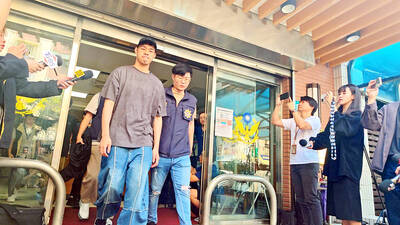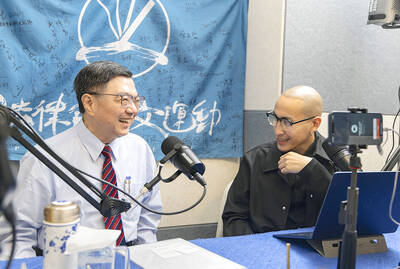Nanya Technology Corp (南亞科技), the nation’s second-largest maker of computer memory chips, and its US partner Micron Technology Inc said yesterday they would not team up with state-led Taiwan Memory Co (TMC, 台灣記憶體公司) to avoid potential technology leaks.
The announcement ended speculation about a possible four-way cooperation with TMC, which last week chose Japan’s Elpida Memory Inc as its technological partner.
But, Nanya and Micron yesterday urged the government to give them the same support it planned to give TMC, including a possible cash injection to accelerate technological migration.
TMC said last month it hoped for a NT$30 billion (US$888 million) capital injection from the government.
“Micron decided not to join the TMC under its current structure,” Fred Fishburn, an assistant vice president of Inotera Memories Inc (華亞科技), a joint venture between Nanya and Micron, told a press briefing in Taipei.
“Our biggest concern is technology contamination,” Fishburn told reporters. “We [would] risk losing technologies to Elpida.”
Furthermore, the companies doubt the framework proposed by TMC would work, he said.
Micron intends instead to increase cooperation with Inotera and Nanya on next-generation technologies and research and development efforts in Taiwan, Fishburn said.
Last year, Micron signed a 10-year agreement with Nanya on technological cooperation.
In response, TMC head John Hsuan (宣明智) said in a statement that the company respected the decision made by Micron and Nanya.
On April 1, Hsuan said TMC wanted additional technological support from Micron after picking Elpida as it technological partner.
Nanya chairman Wu Chia-chau (吳嘉昭) said he hoped the government would nevertheless support the chipmaker’s efforts as the government’s policy is to help memory companies enhance their competitiveness by developing their own technologies.
“If possible, we hope the government will subscribe to new shares of Nanya and Inotera,” Wu said.
The companies will decide the scale of new share issues at board meetings later this month, he said.
Nanya has said it would need between NT$20 billion and NT$30 billion per plant with a monthly capacity of 30,000 12-inch wafers to upgrade from 68-nanometer to more cost-effective 50-nanometer technology.
Nanya and Inotera plan to begin the migration in the third quarter of this year. Nanya said its capital spending this year would rise to nearly NT$20 billion from NT$12 billion last year.
Liu Szu-liang (劉思良), a memory industry analyst with Yuanta Securities and Investment Consulting (元大投顧), said Nanya would need the government’s help.
“Since the investment in developing new technologies will be huge, Nanya will need the government’s financial support to do it,” Liu said by phone yesterday. “The company’s constant losses have put its parent company, Formosa Plastics Group [台塑集團] under heavy financial pressure.”
Nanya accumulated NT$24.84 billion in losses in the first three quarters of last year after reporting NT$12.46 billion in losses in 2007.
Meanwhile, the Central News Agency reported that Minister of Economic Affairs Yiin Chii-ming (尹啟銘) said yesterday the ministry respected Micron’s decision.
Yiin declined to say whether the government would offer funds to Micron and Nanya.

Taiwanese Olympic badminton men’s doubles gold medalist Wang Chi-lin (王齊麟) and his new partner, Chiu Hsiang-chieh (邱相榤), clinched the men’s doubles title at the Yonex Taipei Open yesterday, becoming the second Taiwanese team to win a title in the tournament. Ranked 19th in the world, the Taiwanese duo defeated Kang Min-hyuk and Ki Dong-ju of South Korea 21-18, 21-15 in a pulsating 43-minute final to clinch their first doubles title after teaming up last year. Wang, the men’s doubles gold medalist at the 2020 and 2024 Olympics, partnered with Chiu in August last year after the retirement of his teammate Lee Yang

FALSE DOCUMENTS? Actor William Liao said he was ‘voluntarily cooperating’ with police after a suspect was accused of helping to produce false medical certificates Police yesterday questioned at least six entertainers amid allegations of evasion of compulsory military service, with Lee Chuan (李銓), a member of boy band Choc7 (超克7), and actor Daniel Chen (陳大天) among those summoned. The New Taipei City District Prosecutors’ Office in January launched an investigation into a group that was allegedly helping men dodge compulsory military service using falsified medical documents. Actor Darren Wang (王大陸) has been accused of being one of the group’s clients. As the investigation expanded, investigators at New Taipei City’s Yonghe Precinct said that other entertainers commissioned the group to obtain false documents. The main suspect, a man surnamed

The government is considering polices to increase rental subsidies for people living in social housing who get married and have children, Premier Cho Jung-tai (卓榮泰) said yesterday. During an interview with the Plain Law Movement (法律白話文) podcast, Cho said that housing prices cannot be brought down overnight without affecting banks and mortgages. Therefore, the government is focusing on providing more aid for young people by taking 3 to 5 percent of urban renewal projects and zone expropriations and using that land for social housing, he said. Single people living in social housing who get married and become parents could obtain 50 percent more

DEMOGRAPHICS: Robotics is the most promising answer to looming labor woes, the long-term care system and national contingency response, an official said Taiwan is to launch a five-year plan to boost the robotics industry in a bid to address labor shortages stemming from a declining and aging population, the Executive Yuan said yesterday. The government approved the initiative, dubbed the Smart Robotics Industry Promotion Plan, via executive order, senior officials told a post-Cabinet meeting news conference in Taipei. Taiwan’s population decline would strain the economy and the nation’s ability to care for vulnerable and elderly people, said Peter Hong (洪樂文), who heads the National Science and Technology Council’s (NSTC) Department of Engineering and Technologies. Projections show that the proportion of Taiwanese 65 or older would